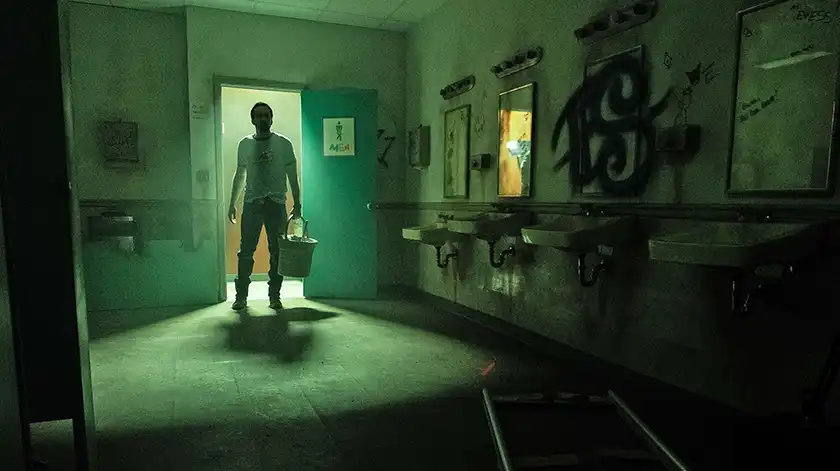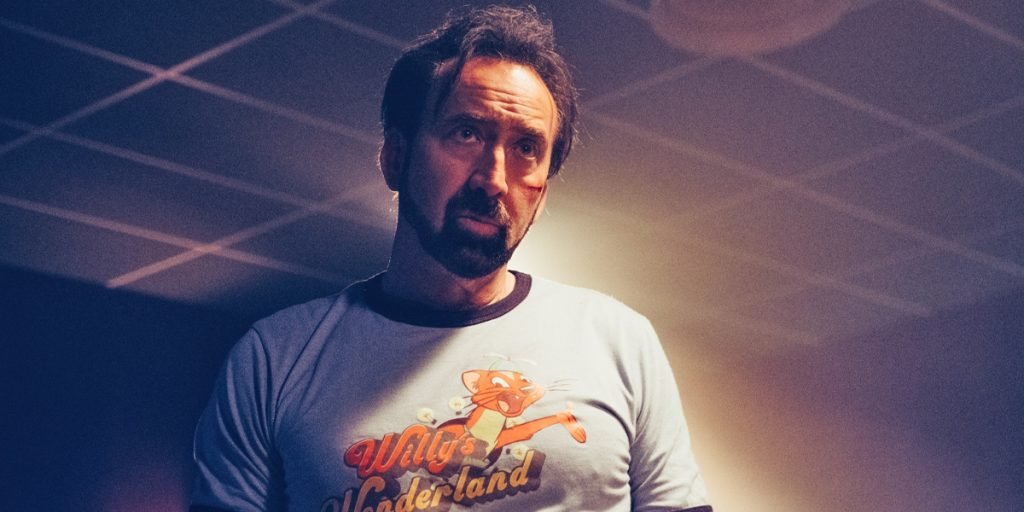Willy’s Wonderland is at its best when embracing its own absurdity, though it often gets bogged down in tired genre tropes.
I don’t think it’s controversial to say that Nicolas Cage has had one of the weirdest careers in Hollywood. From highs including Raising Arizona, Adaptation, and Leaving Las Vegas, to some very famous lows that have been meme fodder for well over a decade, his career spans an immensely wide spectrum of quality. Whenever I see he’s in a new movie, I hold my breath and flip a coin: it feels just as likely we’ll get a Spiderman: Into the Spider Verse or a Color Out Of Space as we will a Ghost Rider: Spirit of Vengeance or a Wicker Man. It’s hard to get a solid quality check on someone so prolific: the man has been in twenty-one films in the last four years alone. So when Willy’s Wonderland was brought to my attention, I held my breath, flipped my coin, and hit play…
Willy’s Wonderland is a comedic slasher film in which Nicolas Cage plays “The Janitor,” a man forced to clean an abandoned children’s restaurant and arcade. At night, however, the fuzzy animatronics that once entertained families with song come to life, in search of blood and death.
It’s a solid premise; one so potentially ridiculous that Cage actually seems like the perfect casting choice. His performance is, oddly enough, a little restrained, as he doesn’t have any actual lines beyond screaming during fight scenes (which, if I’m honest, is also hilarious). Instead of a cavalcade of all your favorite Nic Cage noises, he instead has to rely on body language to portray character. Cage actually does a commendable job of contrasting The Janitor’s silent external stoicism with a goofier side he shows in private while being amazing at pinball and chugging what I assume is a fictional canned drink called “Punch.”
Willy’s Wonderland actually handles The Janitor’s character really well from all angles. First, I like how we don’t really get to know him. Because he doesn’t speak, you don’t have to worry about boring info dumps into his back story. Instead, you get to piece his story through context clues; everything from small details in his car, to his wardrobe, to how he carries himself all work together to allow you to build your own narrative in your mind. All of these things work together to tell you all you need to know about his character because, let’s be honest here, if you’re watching this movie, it’s not for a nuanced character study of a silent man cleaning bathrooms: you’re here to watch Nic Cage fight evil robots.

Cage’s external seriousness perfectly complements the absurdity of the whole film, easily making him and his scenes the best part of the movie. If you’ve read this far, however, you’re likely thinking to yourself “Thaddeus gave this a 3-out-of-5, so he’s probably about to talk about the things he didn’t like.” And you’re right!
I wish the movie’s focus would have stayed on Cage throughout the whole thing, but alas, there’s a supporting cast. Not that any of the actors are bad, but the writing does them no favors. Early on, we get introduced to a group of disposable teenagers who, if you know slasher tropes at all, are here for exactly the reasons you think they’re here. On top of that, they are the same stock archetypes you’ve come to expect: there’s the horny couple, the guy who grows his own weed, the guy who’s in love with the main girl but probably won’t end up with her; all of the usual suspects. With a movie as bonkers as Willy’s Wonderland, I was hoping there’d be trope subversions, or at least some interesting characterization to justify the large chunk of time devoted to these characters. But no, the teenagers come across as bland and expendable: you could take them out of the film and the general plot would not change.
Most of Willy’s Wonderland’s technical side is fine, but I have to single out the cinematography for being… inconsistent. On one hand, there are pretty good shots that are both well-crafted and add to the film’s charm. My favorite is a slow zoom into a closeup of Nic Cage dramatically peering over his sunglasses over an intense soundtrack to intensely stare at a sign of a cartoon weasel: it made me chuckle audibly. But for every good shot like that, there are others that will make you think “why are they making this choice?”
This movie loves to employ fisheye lenses, but keeps using them for shots that really don’t call for them, and would have been better served by a simple medium or wide shot. It’s not like the fisheye serves as a recurring visual motif to highlight danger or madness. It just keeps getting used in a manner that feels like maybe the cinematographer just thought it looked cool, and not because it was an effective choice to make.
Finally, I wanted to talk about the fight choreography because it looked cool… I think…? I’m unsure, actually, because during fight sequences, you’re subjected to the dreaded return of shaky cam! Damn you, shaky cam! How dare you defile this film with your presence! Why must you continue to plague us and ruin perfectly good action sequences!? This is a crime that cannot go unpunished, and will be reflected in my final score.
All in all, Willy’s Wonderland is… OK. I mean, I don’t regret having watched it, I’m just not clamoring to see it again. The parts that just focus on Nicolas Cage and the evil animatronics are really fun, but the movie’s promised wackiness gets diluted by tired genre tropes and questionable technical decisions. This is a great movie to half-watch with your friends over drinks, or to have in the background during a Halloween Party. But I don’t see it ascending in popularity beyond being an obscure cult film.
Signature Entertainment Presents Willy’s Wonderland on Digital Platforms 12th April and DVD & Blu-ray 19th April, 2021.

